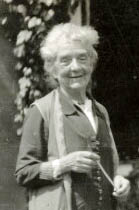Mary Sargant Florence
Mary Sargant Florence | |
|---|---|
 | |
| Born | Emma Mary Sargant 21 July 1857 London, United Kingdom |
| Died | 14 December 1954 (aged 97) Twickenham, United Kingdom |
| Nationality | British |
| Alma mater | Slade School of Art |
| Occupation | Painter, suffragette |
| Spouse(s) | Henry Smyth Florence
(m. 1888–1891) |
Emma Mary Sargant Florence (21 July 1857 – 14 December 1954) was a British painter of figure subjects, mural decorations in fresco and occasional landscapes in watercolour and pastel.
Biography[]

She was born in London, née Sargant. Her father, Henry Sargant, was a barrister and her mother, Catherine Emma Beale. Her siblings included: judge Charles Henry Sargant, botanist Ethel Sargant, headmaster Walter Lee Sargant and the sculptor Francis William Sargant.
She studied in Paris under Luc-Olivier Merson, and, at the Slade School under Alphonse Legros.[1] She was a member of the New English Art Club and the Society of Painters in Tempera.
In 1888 she married Henry Smyth Florence, an American musician.[1] They had two children: Philip Sargant Florence, the economist, and Alix Strachey, the psychoanalyst and translator of Freud. She lived in Nutley, New Jersey in a carriage house that became a studio used by other local artists.[2] After her husband's death by drowning in 1891, she moved to Marlow, Buckinghamshire, and built her house "Lord's Wood" (1899–1900), where she lived until 1940. The interior has been altered but was originally designed to have bare brick walls, no doors and no plumbing.[3]
She is known for her works Children at Chess (c.1903), Suffer Little Children to Come unto Me (1913) and Pentecost (c.1913). She painted true fresco decorations at the Old School, Oakham, Rutland (c.1909–14), and at Bournville Junior School near Birmingham (1912–14). Her frescoes at Oakham School were commissioned by the headmaster, her brother, Walter Lee Sargant, and illustrate the Arthurian story of Gareth.[4]
She was a suffragist, a supporter of the Women's Tax Resistance League, and a member of the committee for the Hague Peace Congress of 1915.[5] With the Cambridge scholar and editor Charles Kay Ogden, she published a book on militarism and feminism, which argued that women had the prerogative and responsibility to combat international militarism.[6] It traced the historical connections between and among militarism, imperialism, slavery, and women's subjection. Militarism, it argued, was the predominant factor in the political, economic, and sexual subjugation of women across a wide swath of human history and the late emergence of demands for women's rights.[7]
In 1940, she wrote Colour Co-Ordination, a work on the history, theory and aesthetics of colour.[8] She edited two volumes of the papers of the Society of Painters in Tempera.
She died at Twickenham, Middlesex.
References[]
| Library resources about Mary Sargant Florence |
| By Mary Sargant Florence |
|---|
- ^ Jump up to: a b Frances Spalding (1990). 20th Century Painters and Sculptors. Antique Collectors' Club. ISBN 1-85149-106-6.
- ^ Chlak, Victoria. "Nutley opinion: Artist's work shows up across the pond", Nutley Sun, March 31, 2016. Accessed July 31, 2019. "The Enclosure was known for being an artists' colony during the years, but it wasn't the only place in town that has been the home of painters and 'etchers.' Several blocks away, tucked almost out of view on Vreeland Avenue, sits a tiny carriage house that served as a studio for many Nutley artists.... In the late 1800s, an Englishwoman named Mary Sargant Florence was the first artist to live there."
- ^ Historic England. "Lord's Wood (1332156)". National Heritage List for England. Retrieved 13 May 2017.
- ^ The quest for the Grail: Arthurian legend in British art, 1840-1920 (p68-9) by Christine Poulson
- ^ Sharon Ouditt. Fighting forces, writing women: identity and ideology in the First World War, Routledge, 1993 ISBN 0-415-04705-6 ISBN 978-0415047050
- ^ C.K. Ogden and Mary Sargant Florence. Militarism versus Feminism: An Enquiry and a Policy Demonstrating that Militarism involves the Subjection of Women, London: Allen and Unwin, 1915
- ^ Ogden and Florence, "Militarism versus Feminism"
- ^ M. Sargant Florence. Colour Co-ordination, London: John Lane, 1940
- 1857 births
- 1954 deaths
- 19th-century British painters
- 20th-century British painters
- Alumni of the Slade School of Fine Art
- Artists from London
- British illustrators
- English tax resisters
- Fresco painters
- People from Nutley, New Jersey
- International Congress of Women people